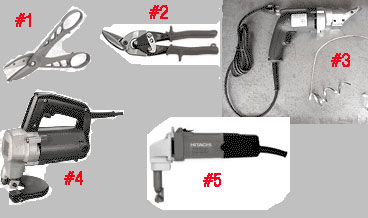Cutting Stove Pipe and Sheet Metal
To make a cake, you've got to break some eggs, and to install a stove you usually have to cut some sheet metal. Instead of learning the hard way, you can read these tips given on our Forum by experienced sheet metal pros.
Note: this material taken from Forum Thread:
http://www.hearth.com/econtent/index.php/forums/viewthread/8478/
Note: Sheet metal thickness is stated as
gauge , which is also abbreviated as ga.
Safety First
Gloves and Eye protection are suggested before you start working with sheet metal and/or power tools.
Tools of the Trade
Hacksaws are not recomended for normal sheet metal cutting. However, they may come in handy with enameled pipe or heavy-duty welded 22 gauge or heavier metal.
Below are some of the common tools and the pros and cons of each:
#1 Hand Shears - Straight
#2 Hand Shears - Aviation type (straight, right or left)
#3 Power Shears - Scissor type (Kett, etc.)
#4 Power Shears - Square Blade (Makita, etc.)
#5 Power Shears - Nibblers (Trumpf, etc.)
Hand Shears - Straight: These are good for cutting flat sheet metal and lines which are fairly straight. They can easily cut snap-lock stove pipe (before it is snapped together) since this metal is flattened as you cut. In general, steel up to 22 ga and stainless up to 24 ga can be cut with a decent pair of these snips. A lot of flea markets (and ebay) sell the old heavy straight shears for $3. to $20. - they will last forever. New shears are $10 to $40, and can be has in either solid steel models, or alloy units which have lightweight bodies and replaceable hardened steel blades. Every pro should have a pair (or more) of these in the toolbox, and even the handy homeowner is likely to find uses for them in the workshop and around the house.
Hand Shears - Aviation type (straight, right or left) A good set of Wiss aviation snips can do a lot in the right hands. But dont buy a cheap knock-off set. They are available in straight (yellow), red (left) and green (right).
Aviation snips have a relatively short blade lengths and also many are serrated. The result is an edge that is less than clean, although with lighter gage metals (24, 26 or lighter), the results can be good.
Aviations are used to cut out of the round holes, etc. in fireplace block offs. There are also some offset aviations (like a duck bill), which can do a nice job.
If the pipe is round you need to use both the red and green shears to cut a strip out of the pipe. The red shear cuts to the left, the green shear cuts to the right. But if used together to cut something like a 1" strip out of the pipe, it will curl in front of the shears and allow you to make a nice clean cut.
Power Shears - Scissor-type (Kett, etc) These are OK for cutting straight flat sheet metal, but are not the preferred shears for pros cutting stove pipe. They can have difficultly cutting through the seams of stove pipe, which are often double or triple the thickness of the rest of the pipe. They also will not cut circles well, such as in fireplace block off plates.
Power Shears - Square Blade (Makita, etc.) These shears will cut straight of in curves, circles or angles. They can cut both flat sheet metal and also round stove pipe. If these shears are used for welded pipe, you must waste the cut-off part since the wide base does not allow these to be started from a drilled hole or other hole knocked into the center of the pipe. This is a great shear for the pro to have in their toolbox for regular use.
Power Shears - Nibblers (Trumpf, etc.) A nibbler "nibbles" the sheet metal by removing small round pieces as it is moved forward. It can cut very thick sheet metal in any direction. It is usually reserved for heavier sheet metal although it will make a fine addition to any tool collection. A nibbler it typically slower than a square-blade shear and it is actually removing materials as opposed to simply shearing it.
Other tips:
Another tip to make the snips work even better is put a drop of oil on the cutting edge before starting. Makes them work much more smoothly.
To start a cut in the middle of a larger piece of sheet metal (fireplace plate, etc.), take a flat blade screwdriver and pound the blade on the side edge through the metal like a knife. It sounds crude, but is standard practice. It helps to use a nice screwdriver like a Malco 3/8 blade for this purpose.
Don't try to make the first cut right on the line, especially if you are not used cutting sheet metal. Make a rough cut on the inside of the line (maybe 1/4" away) first. Then make your final cut on the line. This will keep the scrap metal smaller, which is especially helpful when cutting with right or left aviation snips.
(Hand Shears only) - Stovepipe - When your cut comes to the fold-over lock seam, either switch to a straight snip for the cut or carefully hacksaw the seam.
(Crimped Stove Pipe) - when possible, cut from the female (non-crimped) end so that the pipe will assemble normally. If you need to make additional crimps, a set of 5 blade crimpers can be purchased (Malco is a leading brand)
Note: Stove pipe is often available in various lengths and in slip joints. The use of proper size pieces and slip joints may eliminate the need for cuts.


